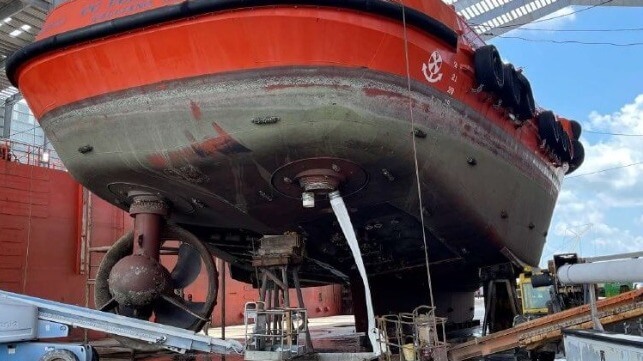Excess Speed Caused Tug Grounding in Corpus Christi Ship Channel

The NTSB has released its report on the grounding of a harbor tug outside of the Corpus Christi ship channel in 2022, and it has determined that excess speed was the likely cause.
On August 7, 2022, CC Portland was assisting the LNG carrier LNG Fukurokuju on an inbound transit through the ship channel. Three other Edison Chouest tugs accompanied the vessel, CC Gregory, CC Aransas and CC LaQuinta.
The CC Gregory made up a tow line through the center chock on Fukurokuju's stern as the ship entered the channel, and CC Portland stood by near buoys 25 and 26 to await the inbound ship's arrival. The LNG carrier approached, making eight knots, and CC Portland matched speed and maneuvered to a position alongside Fukurokuju's starboard bow. The deck crew aboard the tug and the LNG carrier passed a heaving line through a centerline chock on the ship's bow, and at 1623 CC Portland sped up (astern) in order to get ahead of the ship as the crew passed up the tow line.
The tug's mate was at the helm in a training capacity, and the master was overseeing the maneuver in the pilothouse. As the harbor tug took on more speed astern, the mate had trouble maintaining heading. The tug began to fishtail, then to veer off to its starboard side (Fukurokuju's port, as the tug was facing opposite the direction of motion). It lost speed and was overtaken by Fukurokuju, and the towline (which had not yet been hooked up) dipped into the water. The heaving line eventually parted from the strain.
According to the mate, there was no response from the tug's port side z-drive, and the tug simply "wouldn't go to port." The stern continued to slide to starboard, and the mate soon realized that the tug was going to go aground. It struck bottom at 1625, just two minutes after the maneuver began to go wrong.
The captain activated the emergency release on the tug's tow winch in case the towline was connected to Fukurokuju and notified the pilots on board the LNG carrier that the tug had gone aground. CC Portland's crew noticed oil in the water shortly after, and they shut down the main engines and deployed spill kit gear to control the risk of pollution.
The U.S. Coast Guard arrived to assess the damage and determined that about 4-5 gallons of fuel had leaked from the tug, and there was no active sheening. The tug CC LaQuinta towed CC Portland off the bank and back to a pier at Harbor Island for an inspection.
Damage to the tug was substantial. The starboard z-drive had sheared off and was missing; the port z-drive had been fouled by the tow line; three keel coolers had been damaged; and a support bracket had ripped off, leaving a large hole in one fuel tank. The total repair cost came to about $1 million.
The mate at the helm of the tugboat had been with Chouest for six months and was working through the company's internal training program for towing operations. During the casualty investigation, his assessors raised questions about the accuracy of his training record documentation, as well as his ability to perform the bow towing evolution.
"Nearly all training masters that had reportedly signed off on the mate’s training raised concerns that many of the initials on the mate’s sign-off sheet either did not match their own handwriting or were for training elements, positions, or maneuvers that they never completed with the mate," reported NTSB.

that matters most
Get the latest maritime news delivered to your inbox daily.
Making up tow at the bow position is one of the most difficult tasks for a harbor tug, according to NTSB: it is done while moving astern at speed, in an area of elevated pressure around the ship's bulbous bow. If the vessel is moving quickly - as the LNG carrier was that day - the tug is running its engines near maximum in order to keep up, and has little reserve power available to maneuver if something goes wrong. The ship was making about 8.5 knots at the time of the casualty, and experienced masters surveyed by NTSB (and others) put the maximum safe speed for the maneuver in the range of 5-7 knots.
"Owners and operators of ASD tugboats that perform bow-to-bow harbor-assist operations should set speed limits for these maneuvers," concluded NTSB. "Tugboat operators should communicate these pre-determined speed limits to pilots and ship masters."
